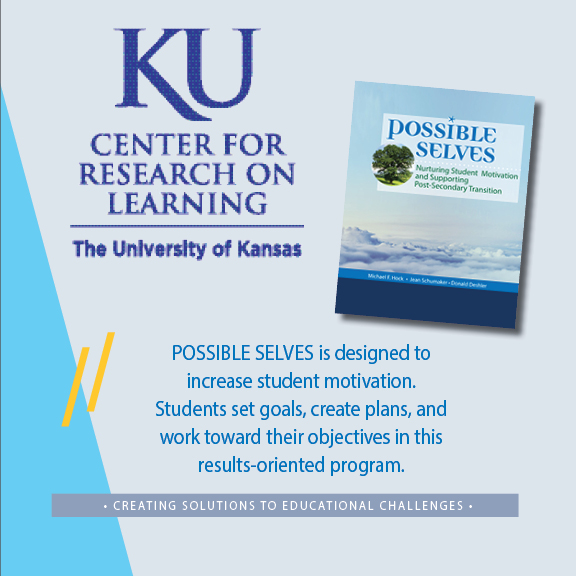Possible Selves: Nurturing Student Motivation
Possible Selves is designed to increase student motivation by having students examine their futures and think about goals that are important to them. Students think about and describe their hoped-for possible selves, expected possible selves, and feared possible selves. They set goals, create plans, and work toward their goals as part of this program.
In research studies, students in the Possible Selves condition scored significantly higher than students in the control group on measures of goal identification. In one study involving college student-athletes, at the end of six years, the students in the Possible Selves group earned higher grade-point averages (2.65) than students in the control group (2.25) and in a career-counseling group (2.41). In addition, 75 percent of the students in the Possible Selves group graduated from the university compared to 45 percent of students in the control group and 60 percent of students in the career-counseling group.

Author(s): Michael F. Hock, Jean B. Schumaker, and Donald D. Deshler
Publication and Purchasing Information: University of Kansas, Center for Research on Learning (First Edition 2003; Second Edition 2023) / KU CRL Online Store
Resources:
- Possible Selves Research (pdf)
- Possible Selves presentation (ppt)
- Possible Selves tree examples (ppt)
- Strategram Vol. 9, No. 4: June 1997: Student Motivation and Commitment, A Cornerstone of Strategy Instruction (Possible Selves) (pdf)
Research Articles:
- Wenhao Wang, Kingston Neal, Gail C. Tiemann, Michael F. Hock. (2021). Applying Evidence-Centered Design in the Development of a Multidimensional Adaptive Reading Motivation Measure. Educational Measurement Issues and Practice. August 2021.
- Stringfellow, Jennifer L, "Effects of possible selves instruction on self-determination of students with learning disabilities" (2007). UNLV Retrospective Theses & Dissertations. 2749.
http://dx.doi.org/10.25669/vpb7-wux5 DOI:10.1111/emip.1246812 - Hock, M.F., Deshler, D.D., & Schumaker, J.B. (2006). Enhancing student motivation through the pursuit of possible selves. In C. Dunkel & J. Kerpelman (Eds.), Possible Selves: Theory, Research and Application. Hauppauge, NY: Nova Science Publishers. This chapter describes the Possible Selves program and the results of three studies involving university-level student-athletes and middle school students.
The Story Behind the Possible Selves Program from author Mike Hock:
While I was directing the academic support program for student athletes at the University of Kansas, I noticed that although we were teaching the students the skills and strategies that they needed to succeed at the college level, many of them did not seem motivated to earn good grades and complete their college degrees. Their ideas focused on becoming professional athletes, and they viewed college as an unwanted, but necessary, steppingstone to the pros. I knew that the very large majority of them had no chance of ever reaching the professional ranks, and I wanted to help them open their minds to other possibilities for their futures.
As I was researching possible options for programs for motivating these students, I came upon the concept of “possible selves.” Possible Selves is a concept that was first introduced by Hazel Markus of Stanford University. The basic notion associated with this concept is that most people have visions of themselves in the future. Once these visions are clearly articulated or surfaced, they can be motivational. That is, people will strive to attain these visions of what is possible for them while avoiding what they don’t wish to become. The Possible Selves program is designed to open students’ minds to the wide variety of possible futures that they might experience, including the futures that they dream about, the futures that they expect, and the futures that they fear. I reasoned that joining the professional ranks in a sport might be a “dreamed about” future, but that there were other possibilities that the students should be considering. I worked with Don and Jean to develop a program that could be used with the student athletes to put them in touch with their possible selves beyond the athletic domain and then broadened the program to apply to younger students as well.
Author's Thoughts about the Possible Selves Program:
The Possible Selves Program has now been tested with students at the elementary, middle-school, high-school, and college levels and has been successful at all levels. As a result of the program, students set more goals for themselves in many more areas than they do before they participate in the program, and they achieve more success within educational settings than do students who do not participate in the program.
Teacher and Student Feedback on the Possible Selves Program:
Teachers and students rate the Possible Selves Program highly. The program has been adopted as a part of two adolescent literacy programs that are being used nationally.
Please note that professional development, coaching, and infrastructure support are essential components to effective implementation of SIM instructional tools and interventions. It is highly recommended that you work with a SIM professional developer. See the SIM Event list for sessions or email simpd@ku.edu to learn more.